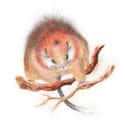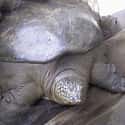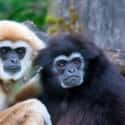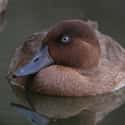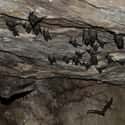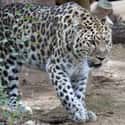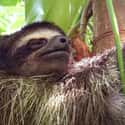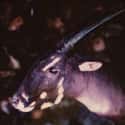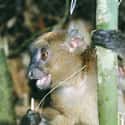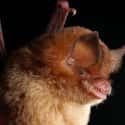-
(#1) Red Crested Tree Rat
- Santamartamys rufodorsalis
Population: Unknown, but in 1898, just two red-crested tree rats existed in captivity. For over a century, the species had not been spotted in the wild.
What Happened: In May 2011, a red-crested tree rat was spotted for the first time in 113 years by two biologists who were camping in a field. From this single sighting, it's impossible to say how many of these rats exist, but there's probably a handful – at least around Colombia's El Dorado Nature Reserve where the first little guy was found.
Because of the sighting, the rat was able to nab a listing as "critically endangered" rather than "extinct."
-
(#2) White Rhinoceros
- Ceratotherium simum
Population: Three
What Happened: Rhinos as a whole are struggling with poaching and the destruction of their natural habitat. It's very possible that during your lifetime, rhinos will no longer exist in the wild. The white rhino is particularly vulnerable because there's just a single male, named Sudan, in existence. The other two white rhinos, named Fatu and Najin, are females. All of the remaining white rhinos live at the Ol Pejeta Conservancy in Kenya where they are guarded from poachers around the clock.
Unfortunately, Sudan is elderly and has a low sperm count. While Fatu is a young 15 years old, Najin is 25 and has weak hind legs which may not support natural mating.
-
(#3) Red River Giant Softshell Turtles
Population: Three (two in captivity, one in the wild)
What Happened: The Red River giant softshell turtle is so endangered that only three of them exist in the entire world. Two are at the Suzhou Zoo in China, and one is in a lake in Vietnam called Dong Mo. Their dwindling population is largely the fault of China's industrialization and the push for renewable energy, which caused a number of dams to be built along the river. As China developed their infrastructure around the Red River in the mid-to-late 20th century, the turtles' habitat was decimated.
In addition to a shrinking habitat, pollution has made it almost impossible for the turtles to hunt. Even if they can thrive in musky, polluted water, Red River giant softshell turtles are particularly vulnerable to poachers: their eggs, meat, and skin are all used in Eastern medicine.
-
(#4) Hainan Black Crested Gibbon
Population: Less than 25
What Happened: The Hainan gibbon, which resides on the Hainan islands in the South China Sea, is the world's rarest primate. Over the last 50 years, deforestation has destroyed the gibbon's natural habitat. On top of that, Hainan gibbons frequently fall victim to poachers who sell them for food and traditional medicine or as pets. Currently, the species and its habitat are protected under law, but that's not enough to truly protect their population.
Something as simple as a disease or natural disaster could completely wipe them out.
-
(#5) Madagascar Pochard
- Aythya innotata
Population: As of 2014, there were just 25 individuals left in the world.
What Happened: Dubbed the world's rarest bird, the Madagascar pochard has suffered at the hands of humans, who have taken over their habitat in order to cultivate rice. According to BBC, humans have driven the birds to just a single wetland, which doesn't have enough food to sustain their population. The ducks primarily search for food at the bottom of lakes, but the lake they were pushed to was simply too deep for them to feed. Because of this, a whopping 96% of chicks die before they're three weeks old, but conservationists hope to restore a nearby lake that would be a more suitable habitat.
Like most herbivores, the diving ducks ensure the gentle balance of plant life in a lake's ecosystem. In some cases, an overgrowth of vegetation can lead to a lack of oxygen which kills off fish and aquatic life.
-
(#6) Seychelles Sheath-tailed Bat
- Coleura seychellensis
Population: Between 30 and 100
What Happened: The poor Seychelles Sheath-Tailed bat used to flourish across the Seychelles islands. It's unclear exactly why the population dipped so drastically, but it's commonly attributed to the introduction of the non-native predatory barn owl and the rise of coconut plantations. Coconut plantations use pesticides, which inadvertently destroy the bats' insect food source.
The bat is now extinct on most islands in the Seychelles, and less than 100 are thought to exist in the world. These bats remain an important creature to the Seychelles' delicate ecosystem because they keep the insect population in check.
-
(#7) Amur Leopard
- Panthera pardus orientalis
Population: 57
What Happened: The world's rarest big cat lives in the Primorye region of Russia, and believe it or not, 57 cats means the subspecies is doing great – at least better than it was. A 2007 census counted around 30 of the cats, but conservationist efforts have helped double their numbers. So why are these cats critically endangered in the first place?
They're poached for their beautiful fur, but without Amur leopards the entire ecosystem suffers. Amur leopards are avid hunters who prey on species like deer, rabbits, and badgers. Food for these preyed-upon animals grows exceedingly scarce as populations boom.
-
(#8) Javan Rhinoceros
- Rhinoceros sondaicus
Population: 58 to 68 individuals
What Happened: Javan rhinos have been hunted to oblivion because their tusks warrant a hefty price tag on the black market. Currently, these rhinos are only found in Ujung Kulon National Park in Java, Indonesia. Javan rhinos are important to local ecosystems, where they increase biodiversity by munching on certain plant species.
The flora and fauna in these areas sustain other species, and if that delicate balance is altered, a whole lot more than just rhinos will suffer.
-
(#9) Three-toed sloth
- Bradypus
Population: 79
What Happened: Though the pygmy three-toed sloth has only been a recognized species since 2001, it has suffered a great deal since then. Pygmy three-toed sloths are only found on Isla Escudo de Veragus, where their already small habitat of mangrove forests is habitually destroyed. Sloths only descend from trees about once a week when they need to urinate or defecate. These slow, gentle creatures need trees to hide from predators.
Pygmy three-toed sloths are an ecosystem in of themselves, carrying a unique species of Trichophilus algae on their backs. As populations dwindle, this algae is also threatened.
-
(#10) Saola
- Pseudoryx nghetinhensis
Population: between 70 to 700 (though current estimates believe the number is closer to the lower range).
What Happened: Saolas are important to biodiversity and remain a food source to even rarer animals of prey (think: tigers). Despite their rarity, many people in Laos and Vietnam depend on Saolas for meat. Unfortunately, it is these very people who caused their population to plummet.
Saolas suffered as Southeast Asia boomed with development and climate change reared its ugly head. The species lives mostly in wet forests at low elevations. In places like Vietnam, these areas are now densely populated, while in places like Laos, these areas no longer exist. Saolas were never really used in Chinese medicine, so they don't carry a hefty price tag for poachers; unfortunately, saolas are frequently killed in the crossfire and caught in traps meant for other animals. Currently, their population is so small that two of their biggest threats are inbreeding or not being able to breed because of isolation.
-
(#11) Greater Bamboo Lemur
- Prolemur simus
Population: The lowest estimate believes just 100 of these creatures exist.
What Happened: Collectively, lemurs are the world's most endangered mammals. Though they remain of great economic importance to Madagascar, where they're a major draw in eco-tourism, a whopping 90% of the 103 known lemur species are threatened. The greater bamboo lemur may be the scarcest, with estimates stating that between 100 and 160 of these animals exist.
Unfortunately, this animal's habitat has been largely destroyed by slash-and-burn agriculture, mining, and illegal logging, and the critters are habitually targets for poachers because of their meat.
-
(#12) Cuban greater funnel-eared bat
Population: Around 100 individuals
What Happened: Bats remain important to local ecosystems to prevent an explosion of insect populations, which could destroy vegetation and lead to the spread of disease. This species of bat, which was previously thought to be extinct, was rediscovered in 1992. It resides in a single cave on the western top of Cuba, though fossils show that it once roamed freely around the island and the Isla de Pinos. In 2005, there were thought to be up to 1,000 bats, but most recently it's said that fewer than 100 individuals exist.
Currently, the species' largest threat is the ongoing collapse of the cave roof at Cueva La Barca. Should this cave fully succumb to erosion, the species would become extinct.
New Random Displays Display All By Ranking
About This Tool
Due to the species' own reasons or being affected by human activities or natural disasters, there are many wild animal species in the world that are facing the danger of extinction. There are more than 100 kinds of vertebrates in the endangered state in the world, about 14 species are caused by natural evolution, and the rest are caused by man-made factors.
Wild animals have become victims of the development of human society, many ancient animal species, which were originally huge in number, went extinct in a short period of time. It is urgent to protect the habitat and restore the damaged ecosystem. You could know 12 endangered animals in this random tool that are fewer than 100 in the world.
Our data comes from Ranker, If you want to participate in the ranking of items displayed on this page, please click here.










